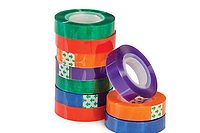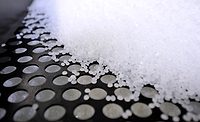Hydrogenated DCPD-Based Resins for SBC-Based Hot-Melt PSAs
Hydrogenated dicyclopentadiene resins affect adhesive performance when used as tackifiers in styrene-block-copolymer-based hot-melt pressure-sensitive adhesives.
 Dicyclopentadiene (DCPD)-based hydrocarbon resins are widely used as tackifiers in many applications. In particular, hydrogenated DCPD-based hydrocarbon resins are frequently used in premium hot-melt adhesives (HMAs) and hot-melt pressure-sensitive adhesives (HMPSAs) because of their water-white color and excellent stability to light and heat.
Dicyclopentadiene (DCPD)-based hydrocarbon resins are widely used as tackifiers in many applications. In particular, hydrogenated DCPD-based hydrocarbon resins are frequently used in premium hot-melt adhesives (HMAs) and hot-melt pressure-sensitive adhesives (HMPSAs) because of their water-white color and excellent stability to light and heat.
Such resins are characterized by their softening point, degree of modification with aromatic olefins and degree of hydrogenation. When the tackifiers are formulated with an elastomeric polymer, these characteristics have a bearing on the adhesive performance.

In this study, various hydrogenated DCPD resins were used as tackifiers to afford styrene-isoprene-styrene (SIS)- and styrene-butadiene-styrene (SBS)-based HMPSAs. Details about the characteristics of the tackifiers are listed in Table 1.
 The adhesives tested in this study were SIS- and SBS-based HMPSA formulations. The SBC/tackifier/plasticizer blend ratio was 25/57/18 by weight. These adhesives were formulated at 180°C over the course of two hours using a laboratory internal mixer. They were then evaluated under controlled temperature and humidity conditions (23°C and 65%, respectively). The adhesives were coated on 40-µm PET film. A ChemInstruments LT-1000 loop tack tester was used to measure the loop tack. The 180° peel adhesion test method (PSTC-1, peel adhesion for single-coated tapes at 180° angle) was used to measure the adhesion strength of the PSAs.
The adhesives tested in this study were SIS- and SBS-based HMPSA formulations. The SBC/tackifier/plasticizer blend ratio was 25/57/18 by weight. These adhesives were formulated at 180°C over the course of two hours using a laboratory internal mixer. They were then evaluated under controlled temperature and humidity conditions (23°C and 65%, respectively). The adhesives were coated on 40-µm PET film. A ChemInstruments LT-1000 loop tack tester was used to measure the loop tack. The 180° peel adhesion test method (PSTC-1, peel adhesion for single-coated tapes at 180° angle) was used to measure the adhesion strength of the PSAs.
A TA instruments AR 2000 was used to measure the rheological properties of the HMPSAs. Specimens with a thickness and diameter of 2 and 8 mm, respectively, were prepared and measured at a shear rate of 1 Hz. Testing temperatures ranged from -50 to 120°C, and the heating rate was 7°C/min.

From the viewpoint of being PSAs, all adhesives have sufficient peel strength adhesion and tackiness; however, some trends were identified. Among tackifiers having the same softening point, those with higher aromatic content had higher peel strength and loop tack compared to those with low or no aromatic content. For example, SU-400, SU-100, SU-100S, and SU-500 have the same softening point; however, SU-400, which has the highest aromatic content, has relatively higher peel strength and loop tack. In addition, tackifiers having a high softening point increase the peel strength and loop tack of SIS-based HMPSAs.
Rheological measurements can be used to describe the characteristics of adhesives and to clarify the tack and high-temperature performance. The glass-transition temperature (Tg) indicates the point at which a polymer changes from a glassy to a rubbery material. The Tg is considered to be the point at which the tan d curve is maximum; hence, the adhesives have different glass-transition temperatures depending on the tackifiers used in their formulation.
Rheological analysis such as a temperature sweep test also provides information about the adhesive’s holding power at high temperatures. Generally, the magnitude of the crossover temperature (where G’ = G” and tan d = 1) of PSAs correlates very well to the actual experimental shear adhesion failure temperature (SAFT).
 The characteristics of tackifiers and the properties of PSAs were statistically analyzed using Minitab Version 14. Pearson’s correlation coefficient (r) was used to compare variables. P < 0.05 was considered statistically significant. Table 2 shows the results of Pearson’s statistics, correlating softening point, molecular weight Mz, and aromatic H wt% of tackifiers with Tg, crossover temperature, and softening point of SIS-based HMPSAs.
The characteristics of tackifiers and the properties of PSAs were statistically analyzed using Minitab Version 14. Pearson’s correlation coefficient (r) was used to compare variables. P < 0.05 was considered statistically significant. Table 2 shows the results of Pearson’s statistics, correlating softening point, molecular weight Mz, and aromatic H wt% of tackifiers with Tg, crossover temperature, and softening point of SIS-based HMPSAs.
The softening point of the tackifier affected the low-temperature properties (e.g., Tg of PSAs) and high-temperature properties (e.g., crossover temperature and softening point of PSAs). The molecular weight of the tackifier mainly affected the low-temperature properties. The aromatic H wt% affected only high-temperature properties.
Figure 2 shows the temperature ranges from Tg to the crossover temperature, as calculated from the rheological analysis of SIS-based HMPSAs. Depending on the characteristics of the constituent tackifiers, the formulated adhesives have different workable temperatures as PSAs. SU-500, a tackifier with no aromatic content, has wider range of workable temperatures than SU-400, a tackifier with high aromatic H wt%, even though both have the same softening point. In tackifiers with higher softening points, the workable temperature range of the PSA shifts to a higher temperature.
Figure 3 shows comparative test results of the adhesive performance of SBS-based HMPSAs using different tackifiers. In these results, only some of the tackifiers exhibit tackiness at room temperature. Tackifiers having an aromatic H wt% higher than 3% and/or a softening point lower than 110°C have significant loop tack strength at room temperature; SU-490, SU-400, H-2300 and SU-90 are examples of such tackifiers.
 Figure 4 shows the temperature ranges from Tg to the crossover temperature, as calculated from the rheological analysis of SBS-based HMPSAs. The patterns observed are similar to those shown in Figure 2, in that a tackifier with no aromatic content has wider range of workable temperatures than one with high aromatic H wt% content, and the workable temperature range of PSAs containing a tackifier with high softening point is shifted to a higher temperature. However, SBS-based HMPSAs have higher glass-transition temperatures than SIS-based HMPSAs. This may be caused by a smaller content of rubbery region to be swelled with tackifier in the former than in the latter.
Figure 4 shows the temperature ranges from Tg to the crossover temperature, as calculated from the rheological analysis of SBS-based HMPSAs. The patterns observed are similar to those shown in Figure 2, in that a tackifier with no aromatic content has wider range of workable temperatures than one with high aromatic H wt% content, and the workable temperature range of PSAs containing a tackifier with high softening point is shifted to a higher temperature. However, SBS-based HMPSAs have higher glass-transition temperatures than SIS-based HMPSAs. This may be caused by a smaller content of rubbery region to be swelled with tackifier in the former than in the latter.
For additional information, contact Kolon Industries, Ltd., 10th Fl., Kolon Tower 1-23, Byulyang-dong, Kwacheon City, Kyunggi-do, Korea; phone (82) 23677-6105; fax (82) 23677-6191; email jjlee@kolon.com; or visit www.kolonindustries.com.

Such resins are characterized by their softening point, degree of modification with aromatic olefins and degree of hydrogenation. When the tackifiers are formulated with an elastomeric polymer, these characteristics have a bearing on the adhesive performance.

Figure 1. Adhesive Performance of SIS-Based HMPSAs Containing Different Tackifiers
Hydrogenated DCPD Resins
There are two main types of DCPD-based hydrocarbon resins: DCPD resins, which predominantly contain DCPD; and DCPD-C9 resins, which contain substantial amounts of aromatic unsaturated components such as styrene, a-methylstyrene, vinyltoluene, or aromatic fractions. The hydrogenation of hydrocarbon resins affords resins that are very light or water-white in color and that possess remarkable stability to light and heat.In this study, various hydrogenated DCPD resins were used as tackifiers to afford styrene-isoprene-styrene (SIS)- and styrene-butadiene-styrene (SBS)-based HMPSAs. Details about the characteristics of the tackifiers are listed in Table 1.

Figure 2. Temperature Ranges as Calculated from Rheological Analysis of SIS-Based HMPSAs
A TA instruments AR 2000 was used to measure the rheological properties of the HMPSAs. Specimens with a thickness and diameter of 2 and 8 mm, respectively, were prepared and measured at a shear rate of 1 Hz. Testing temperatures ranged from -50 to 120°C, and the heating rate was 7°C/min.

Results and Discussion
Every tackifier used in this study can easily tackify SIS and be used to formulate HMPSAs. Figure 1 shows comparative test results of the adhesive performance of SIS-based HMPSAs containing different tackifiers.From the viewpoint of being PSAs, all adhesives have sufficient peel strength adhesion and tackiness; however, some trends were identified. Among tackifiers having the same softening point, those with higher aromatic content had higher peel strength and loop tack compared to those with low or no aromatic content. For example, SU-400, SU-100, SU-100S, and SU-500 have the same softening point; however, SU-400, which has the highest aromatic content, has relatively higher peel strength and loop tack. In addition, tackifiers having a high softening point increase the peel strength and loop tack of SIS-based HMPSAs.
Rheological measurements can be used to describe the characteristics of adhesives and to clarify the tack and high-temperature performance. The glass-transition temperature (Tg) indicates the point at which a polymer changes from a glassy to a rubbery material. The Tg is considered to be the point at which the tan d curve is maximum; hence, the adhesives have different glass-transition temperatures depending on the tackifiers used in their formulation.
Rheological analysis such as a temperature sweep test also provides information about the adhesive’s holding power at high temperatures. Generally, the magnitude of the crossover temperature (where G’ = G” and tan d = 1) of PSAs correlates very well to the actual experimental shear adhesion failure temperature (SAFT).

Figure 3. Adhesive Performance of SBS-Based HMPSAs Containing Different Tackifiers
The softening point of the tackifier affected the low-temperature properties (e.g., Tg of PSAs) and high-temperature properties (e.g., crossover temperature and softening point of PSAs). The molecular weight of the tackifier mainly affected the low-temperature properties. The aromatic H wt% affected only high-temperature properties.
Figure 2 shows the temperature ranges from Tg to the crossover temperature, as calculated from the rheological analysis of SIS-based HMPSAs. Depending on the characteristics of the constituent tackifiers, the formulated adhesives have different workable temperatures as PSAs. SU-500, a tackifier with no aromatic content, has wider range of workable temperatures than SU-400, a tackifier with high aromatic H wt%, even though both have the same softening point. In tackifiers with higher softening points, the workable temperature range of the PSA shifts to a higher temperature.
Figure 3 shows comparative test results of the adhesive performance of SBS-based HMPSAs using different tackifiers. In these results, only some of the tackifiers exhibit tackiness at room temperature. Tackifiers having an aromatic H wt% higher than 3% and/or a softening point lower than 110°C have significant loop tack strength at room temperature; SU-490, SU-400, H-2300 and SU-90 are examples of such tackifiers.

Figure 4. Temperature Ranges as Calculated from Rheological Analysis of SBS-Based HMPSAs
Conclusion
This article shows the correlation between the characteristics of tackifiers and the adhesive performance of styrene-block-copolymer-based HMPSAs. The higher the softening point of the tackifier, the higher the Tg, softening point and crossover temperature of the PSAs. High aromatic H wt% content reduces the high-temperature resistance of PSAs, as suggested by the decrease in the crossover temperature and softening point of the PSAs. Only some tackifiers that have high aromatic H wt% content and/or low softening point exhibit tackiness at room temperature when they are used to formulate SBS-based HMPSAs.For additional information, contact Kolon Industries, Ltd., 10th Fl., Kolon Tower 1-23, Byulyang-dong, Kwacheon City, Kyunggi-do, Korea; phone (82) 23677-6105; fax (82) 23677-6191; email jjlee@kolon.com; or visit www.kolonindustries.com.
Links
Looking for a reprint of this article?
From high-res PDFs to custom plaques, order your copy today!





